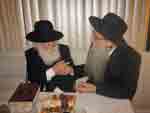
Shmuel Berenbaum
Encyclopedia

Rosh yeshiva
Rosh yeshiva, , , is the title given to the dean of a Talmudical academy . It is made up of the Hebrew words rosh — meaning head, and yeshiva — a school of religious Jewish education...
of the Mir yeshiva
Mir yeshiva (Brooklyn)
The Mir yeshiva , commonly known as the Mirrer Yeshiva or The Mir, is officially registered with the College Board as the Mirrer Yeshiva Central Institute. It is a prominent, Haredi yeshiva located in Brooklyn, New York known for its excellence in talmudic studies.Its long-time Rosh Yeshiva was...
in Brooklyn, New York City which includes an elementary school and a high school, as well as its post-graduate Talmudical Academy, and a Kollel
Kollel
A kollel is an institute for full-time, advanced study of the Talmud and rabbinic literature. Like a yeshiva, a kollel features shiurim and learning sedarim ; unlike a yeshiva, the student body of a kollel are all married men...
.
History
Rabbi Berenbaum was born in KnyszynKnyszyn
Knyszyn is a town in north-eastern Poland, northwest of Białystok. It is situated in the Podlaskie Voivodeship , and was formerly in the Białystok Voivodeship ....
, Poland in March 1920, and studied at Ohel Torah Yeshiva in Baranovich
Baranovichi
Baranovichi , is a city in the Brest Province of western Belarus with a population of 173,000. It is a significant railway junction and home to a state university.-Overview:...
, led by Rabbi Elchonon Wasserman
Elchonon Wasserman
Elchonon Wasserman was a prominent rabbi and rosh yeshiva in pre-World War II Europe. He was one of the Chofetz Chaim's closest disciples and a noted Torah scholar.-Biography:...
. He later studied in the Mir Yeshiva
Mir yeshiva (Poland)
The Mir yeshiva , commonly known as the Mirrer Yeshiva or The Mir, was a Haredi yeshiva located in the town of Mir, Russian Empire...
located in the town of Mir
Mir, Belarus
Mir is an urban settlement in Kareličy raion, Hrodna Voblast, Belarus on the banks of Miranka River, about 85 kilometers southwest of the national capital, Minsk....
, Poland. At the onset of World War II, he traveled with the rest of the Mir Yeshiva to Wilno, Poland (now Vilnius, Lithuania
Vilnius
Vilnius is the capital of Lithuania, and its largest city, with a population of 560,190 as of 2010. It is the seat of the Vilnius city municipality and of the Vilnius district municipality. It is also the capital of Vilnius County...
) where they remained for three weeks, awaiting visas to travel abroad. After receiving destination visas to Curaçao
Curaçao
Curaçao is an island in the southern Caribbean Sea, off the Venezuelan coast. The Country of Curaçao , which includes the main island plus the small, uninhabited island of Klein Curaçao , is a constituent country of the Kingdom of the Netherlands...
, a Dutch protectorate in the Caribbean
Caribbean
The Caribbean is a crescent-shaped group of islands more than 2,000 miles long separating the Gulf of Mexico and the Caribbean Sea, to the west and south, from the Atlantic Ocean, to the east and north...
, they were given travel visas by the Japanese Consul in Kovno
Kaunas
Kaunas is the second-largest city in Lithuania and has historically been a leading centre of Lithuanian economic, academic, and cultural life. Kaunas was the biggest city and the center of a powiat in Trakai Voivodeship of the Grand Duchy of Lithuania since 1413. During Russian Empire occupation...
, Chiune Sugihara
Chiune Sugihara
was a Japanese diplomat who served as Vice-Consul for the Japanese Empire in Lithuania. During World War II, he helped several thousand Jews leave the country by issuing transit visas to Jewish refugees so that they could travel to Japan. Most of the Jews who escaped were refugees from...
. The yeshiva traveled across the Trans-Siberian Railway
Trans-Siberian Railway
The Trans-Siberian Railway is a network of railways connecting Moscow with the Russian Far East and the Sea of Japan. It is the longest railway in the world...
to Vladivostok
Vladivostok
The city is located in the southern extremity of Muravyov-Amursky Peninsula, which is about 30 km long and approximately 12 km wide.The highest point is Mount Kholodilnik, the height of which is 257 m...
in a trip that took over two months. From there they traveled to Kobe, Japan, where they remained for 7 months before being settled by the Japanese Government in Shanghai, China.
Following the war, Berenbaum traveled with the remnants of the Mir Yeshiva to the United States where he settled in Brooklyn, New York. Berenbaum married the eldest daughter of the Mir rosh yeshiva, Rabbi Avrohom Kalmanovitz.
In 1952, after the passing of his father-in-law, he became the rosh yeshiva of the Mirrer Yeshiva together with his brother-in-law Rabbi Shraga Moshe Kalmanovitz. He led the yeshiva for the next 56 years. His diligence in Torah study was legendary and he was known to spend the entire day in the yeshiva's study hall speaking with the students in learning.
As a policy, he would not attend any functions or weddings until after the afternoon seder
Seder
Seder is a Hebrew word meaning "order" or "sequence", and can have any of the following meanings:For Jewish holidays*Passover Seder, a ritualized dinner observed during Passover...
in the yeshiva was over. This caused many weddings to take place late in the evening so as to allow him to officiate. He opposed his yeshiva students going to college, and later banned it outright.
After Berernbaum's first heart attack, the name Refoel was added to his name.
Death
Berenbaum died on January 6, 2008, at his home in Brooklyn, NY from medical complications due to stomach cancer, aged 87. His funeral, held on January 7 at the Mir Yeshiva, was attended by tens of thousands of mourners.His body was flown to Israel for burial in the Sanhedriya cemetery in Jerusalem.

